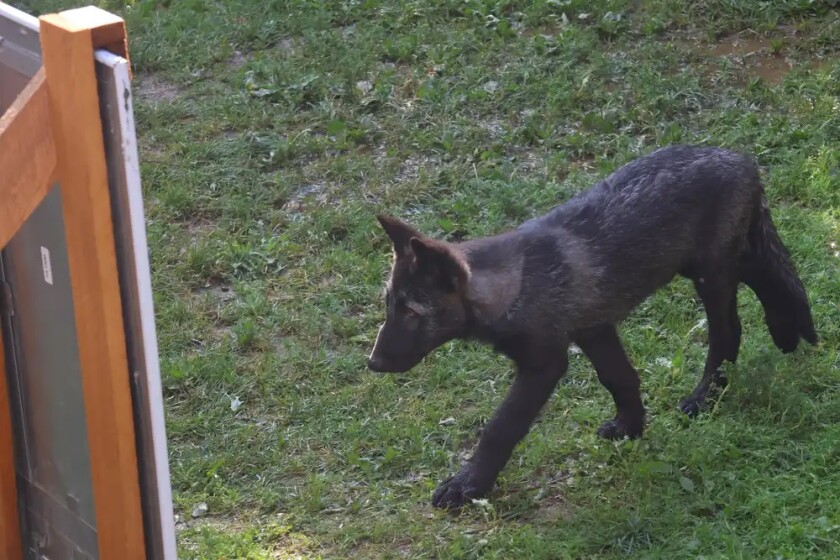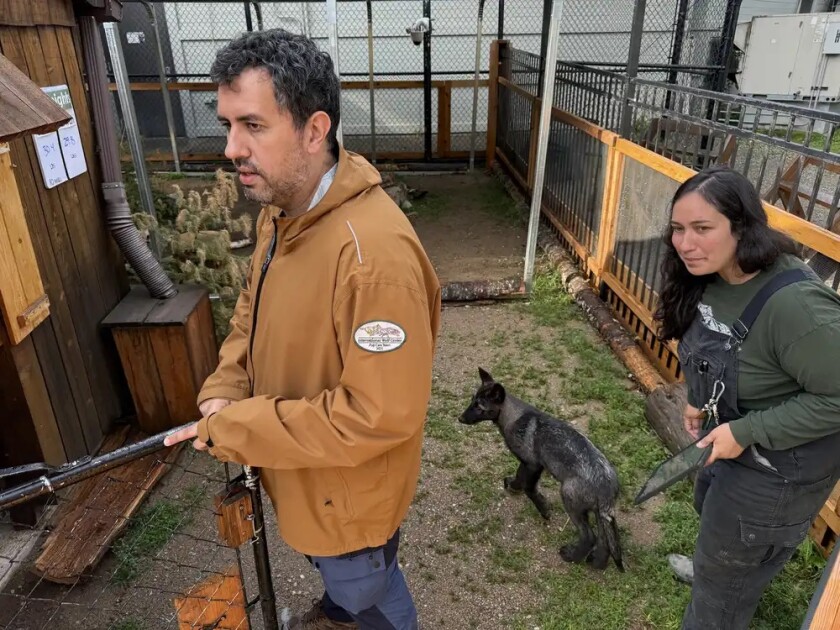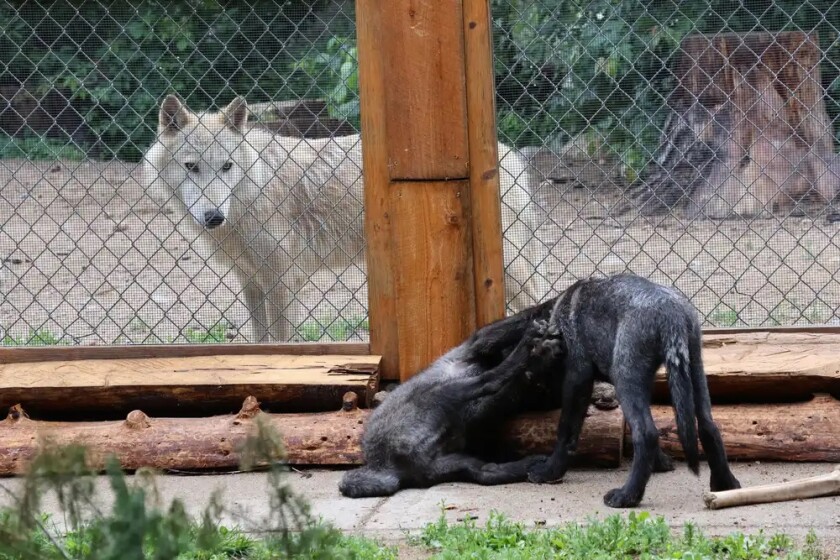ELY, Minn. ŌĆö Early one morning last week, before visitors arrived at the International Wolf Center in Ely, staff members released two small, black, fuzzy wolf pups into a fenced outdoor yard ŌĆö the site of an unusual science experiment.
Propped up inside the pen stood a mirror, about 4 feet tall. The 3-month-old pups, named Cedar and Rowan, bounded over to it, yelping. They looked at their reflections, pawed and sniffed at the mirror, and walked around it, investigating.
ADVERTISEMENT
All the while, Matheus de Mesquita Silveira, a Brazilian researcher, stood quietly nearby, filming their every move.
ŌĆ£They are testing the mirror,ŌĆØ he later explained. ŌĆ£Like, ŌĆśWhatŌĆÖs going on? Can I cross? Can I not cross?ŌĆÖ ŌĆØ
The pups were curious, but they were largely indifferent to the reflections of themselves they saw in the mirror. They didnŌĆÖt exhibit any social reactions, such as fear or anxiety, by backing away or tucking their tails between their legs.

ŌĆ£So they do not invite the image to play with them, or show submission to the image. That shows us that they are not seeing that as another wolf,ŌĆØ Silveira said, adding thatŌĆÖs because wolves are never so indifferent to another wolf.
A philosopher by training, this is the third generation of pups at the Ely wolf center that Silveira has studied to see how they respond to their reflections.
There arenŌĆÖt any wolves in Brazil, but heŌĆÖs been fascinated by them ever since he was a kid when he saw a National Geographic documentary featuring scientist Dave Mech, who founded the International Wolf Center in 1985.
Silveira has been coming to Ely for the past decade as part of his work exploring wolvesŌĆÖ social cognition and behaviors.
ADVERTISEMENT
HeŌĆÖs one of two scientists working with the new pups this year. The other is Kathryn Lord, a researcher at the Chan Medical ═ß═ß┬■╗Ł at the University of Massachusetts who studies the evolution and development of behavior in dogs and wolves.
One of the big differences between them is that wolves are ŌĆ£neophobicŌĆØ ŌĆö theyŌĆÖre fearful of anything new, and much more so than dogs. Lord believes that trait, along with other key behaviors that are formed when they are very young, could be linked to when they start walking. Wolves start walking a couple weeks earlier than dogs, before they can even see and hear.
Lord is trying to figure out precisely when that happens.
ŌĆ£Which sounds kind of easy, like, just look at them and see when theyŌĆÖre walking,ŌĆØ she said. But in reality, itŌĆÖs much more difficult.
ŌĆ£We canŌĆÖt just write down, ŌĆśCedar is walking today,ŌĆÖ ŌĆØ Lord said. ŌĆ£Because we donŌĆÖt know if he started walking that day, or he probably was doing it the night before or the day before, but we just didnŌĆÖt see it.ŌĆØ
What they needed was a way to quantify it. So she worked with the International Wolf Center to outfit Cedar and Rowan with devices called accelerometers, devices that measure their movement, similar to whatŌĆÖs in a smart watch or a Fitbit. Then they attached them to tiny backpacks that the pups wore.
ItŌĆÖs difficult to find wolf pups to do this kind of research, Lord said.
ADVERTISEMENT
ŌĆ£WeŌĆÖre looking for places that are doing a really fantastic job, raising their pups, socializing their pups for living in captivity. And the International Wolf Center is one of the premier places,ŌĆØ she said.

In charge of that socialization at the Ely International Wolf Center is wolf curator Giselle Narv├Īez Rivera. Her work begins when the wolf pups are still tiny, only about 10 days old. Rivera said she was with them when they first opened their eyes.
ŌĆ£And that first thing that theyŌĆÖll see is us caring for them, bottle feeding. And so that relationship that they develop with us starts really young,ŌĆØ Rivera said.
In her two-and-a-half years at the wolf center, this was RiveraŌĆÖs first time working with a newborn litter of pups.
ŌĆ£So it was pretty special to be there and see them howl for the first time,ŌĆØ she said.
They weighed only about a pound apiece at birth. Now, at about 3 months of age ŌĆö which is toddlerhood for wolf pups ŌĆö they weigh in at more than 30 pounds each.
Wolf Center staff stay with the pups around the clock. ThatŌĆÖs partly to make sure theyŌĆÖre safe, but also to socialize them to humans before they integrate them into the centerŌĆÖs pack of adult wolves thatŌĆÖs on display for visitors.
ADVERTISEMENT
ŌĆ£If they go into the enclosure too young, weŌĆÖre kind of going to miss that opportunity to bond with them, and theyŌĆÖre going to be more bonded to the wolves,ŌĆØ Rivera said.

That bond is important, she said, so the wolves will allow staff to monitor their health and well-being. For example, that morning, Rivera and other staff members pulled out a bunch of burrs stuck in the fur of Grayson, the dominant male in the pack.
ŌĆ£He trusts us. He let us do that. And thatŌĆÖs kind of part of that relationship building that we have with the wolves so we can care for them,ŌĆØ Rivera said.
But even after months of human socialization as pups, Lord said, theyŌĆÖre still wolves. They maintain all their natural hunting behaviors. So while theyŌĆÖre integrated with the pack, they will still need daily human contact to keep up that socialization.
The pups are scheduled to join the pack at the end of the month. And the adult wolves are ready for them. They already interact with the pups through the fence that divides them.
A female wolf has been regurgitating food for them to eat. Others check on them and cry to get their attention. Grayson, the dominant male, occasionally bares his teeth or snarls at them, letting them know where they fit in the social (or pecking) order.
ŌĆ£That's just him telling them, ŌĆśHey, calm down your energy. This is how we roll here.ŌĆÖ So thatŌĆÖs all very important communication that they are learning,ŌĆØ said Rivera.
ADVERTISEMENT
The pups were born in captivity at a similar facility in Wisconsin. Even though they arenŌĆÖt related to the wolves at the center in Ely, the wolves here still produce a hormone in the spring called prolactin that makes the wolves want to nurture the pups and accept them into the pack.
ThatŌĆÖs scheduled to happen very soon for Cedar and Rowan, at the end of July. At that point, data collection for the research will end. And their lives as ambassador wolves at the center will begin.
This story was originally published on MPRNews.org.
____________________________________
This story was written by one of our partner news agencies. Forum Communications Company uses content from agencies such as Reuters, Kaiser Health News, Tribune News Service and others to provide a wider range of news to our readers. Learn more about the news services FCC uses here.











